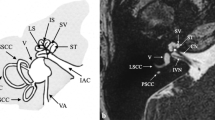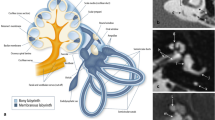Abstract
Introduction
Three-dimensional fast spin-echo Cube (3D-FSE-Cube) uses modulated refocusing flip angles and autocalibrates two dimensional (2D)-accelerated parallel and nonlinear view ordering to produce high-quality volumetric image sets with high-spatial resolution. Furthermore, 3D-FSE-Cube with topical instillation of fluid can also be used for magnetic resonance dacryocystography (MRD) with good soft tissue contrast. The purpose of this study was to evaluate the technical quality and visualization of the lacrimal drainage system (LDS) when using the 3D-FSE-Cube sequence and the 3D fast-recovery fast spin-echo (FRFSE) sequence.
Methods
In total, 75 patients with primary LDS outflow impairment or postsurgical recurrent epiphora underwent 3D-FSE-Cube MRD and 3D-FRFSE MRD at 3.0 T after topical administration of compound sodium chloride eye drops. Two radiologists graded the images from either of the two sequences in a blinded fashion, and appropriate statistical tests were used to assess differences in technical quality, visibility of ductal segments, and number of segments visualized per LDS.
Results
Obstructions were confirmed in 90 of the 150 LDSs assessed. The technical quality of 3D-FSE-Cube MRD and 3D-FRFSE MRD was statistically equivalent (P = 0.871). However, compared with 3D-FRFSE MRD, 3D-FSE-Cube MRD improved the overall visibility and the visibility of the upper drainage segments in normal and obstructed LDSs (P < 0.001). There was a corresponding increase in the number of segments visualized per LDS in both groups (P < 0.001).
Conclusion
Compared with 3D-FRFSE MRD, 3D-FSE-Cube MRD potentially improves the visibility of the LDS.









Similar content being viewed by others
References
Hoffmann KT, Hosten N, Anders N et al (1999) High-resolution conjunctival contrast-enhanced MRI dacryocystography. Neuroradiology 41:208–213
Jing Z, Lang C, Qiu-Xia W et al (2013) High-spatial-resolution isotropic three-dimensional fast-recovery fast spin-echo magnetic resonance dacryocystography combined with topical administration of sterile saline solution. Eur J Radiol 82:1546–1551
Caldemeyer KS, Stockberger SM Jr, Broderick LS (1998) Topical contrast-enhanced CT and MR dacryocystography: imaging the lacrimal drainage apparatus of healthy volunteers. AJR Am J Roentgenol 171:1501–1504
Yoshikawa T, Hirota S, Sugimura K (2000) Topical contrast-enhanced magnetic resonance dacryocystography. Radiat Med 18:355–362
Busse RF, Hariharan H, Vu A et al (2006) Fast spin echo sequences with very long echo trains: design of variable refocusing flip angle schedules and generation of clinical T2 contrast. Magn Reson Med 55:1030–1037
Gold GE, Busse RF, Beehler C et al (2007) Isotropic MRI of the knee with 3D fast spin-echo extended echo-train acquisition (XETA): initial experience. AJR Am J Roentgenol 188:1287–1293
Stevens KJ, Busse RF, Han E et al (2008) Ankle: isotropic MR imaging with 3D-FSE-cube—initial experience in healthy volunteers. Radiology 249:1026–1033
Moraal B, Roosendaal SD, Pouwels PJ et al (2008) Multi-contrast, isotropic, single-slab 3D MR imaging in multiple sclerosis. Eur Radiol 18:2311–2320
Agrawal G, Riherd JM, Busse RF et al (2009) Evaluation of uterine anomalies: 3D FRFSE cube versus standard 2D FRFSE. AJR Am J Roentgenol 193:W558–562
Shahid KR, Spinner RJ, Skinner JA et al (2010) Evaluation of intraneural ganglion cysts using three-dimensional fast spin echo-cube. J Magn Reson Imaging 32:714–718
Kirchhof K, Hahnel S, Jansen O et al (2000) Gadolinium-enhanced magnetic resonance dacryocystography in patients with epiphora. J Comput Assist Tomogr 24:327–331
Cubuk R, Tasali N, Aydin S et al (2010) Dynamic MR dacryocystography in patients with epiphora. Eur J Radiol 73:230–233
Busse RF, Brau AC, Vu A et al (2008) Effects of refocusing flip angle modulation and view ordering in 3D fast spin echo. Magn Reson Med 60:640–649
Alsop DC (1997) The sensitivity of low flip angle RARE imaging. Magn Reson Med 37:176–184
Hennig J, Weigel M, Scheffler K (2003) Multiecho sequences with variable refocusing flip angles: optimization of signal behavior using smooth transitions between pseudo steady states (TRAPS). Magn Reson Med 49:527–535
Herrick RC, Hayman LA, Taber KH et al (1997) Artifacts and pitfalls in MR imaging of the orbit: a clinical review. Radiographics 17:707–724
Mugler JP III, Bao S, Mulkern RV et al (2000) Optimized single-slab three-dimensional spin-echo MR imaging of the brain. Radiology 216:891–899
Mitsouras D, Mulkern RV, Rybicki FJ (2006) Strategies for inner volume 3D fast spin echo magnetic resonance imaging using nonselective refocusing radio frequency pulses. Med Phys 33:173–186
Busse RF, Riederer SJ, Fletcher JG et al (2000) Interactive fast spin-echo imaging. Magn Reson Med 44:339–348
Acknowledgments
This work was supported by grants from the National Natural Science Foundation of China (No.81301192) and the Natural Science Foundation of Hubei Province, China (No. 2012FFB02608, 2012FKB02439).
Ethical standards and patient consent
We declare that all human studies have been approved by the Institutional Review Board of Tongji Hospital affiliated to Tongji Medical College, Huazhong Universitity of Science and Technology, and have therefore been performed in accordance with the ethical standards laid down in the 1964 Declaration of Helsinki and its later amendments. We declare that all patients gave informed consent prior to inclusion in this study.
Conflict of interest
We declare that we have no conflict of interest.
Author information
Authors and Affiliations
Corresponding author
Rights and permissions
About this article
Cite this article
Zhang, J., Chen, L., Wang, QX. et al. Isotropic three-dimensional fast spin-echo Cube magnetic resonance dacryocystography: comparison with the three-dimensional fast-recovery fast spin-echo technique. Neuroradiology 57, 357–365 (2015). https://doi.org/10.1007/s00234-014-1484-2
Received:
Accepted:
Published:
Issue Date:
DOI: https://doi.org/10.1007/s00234-014-1484-2




